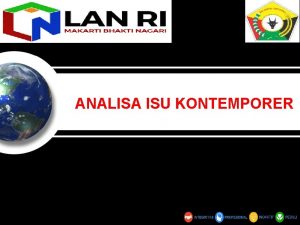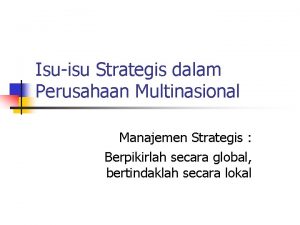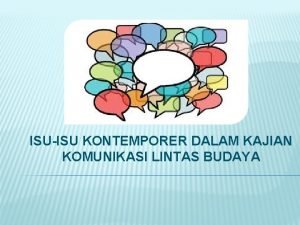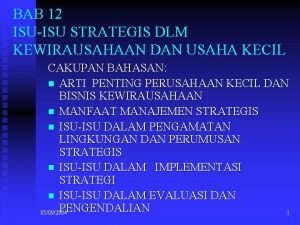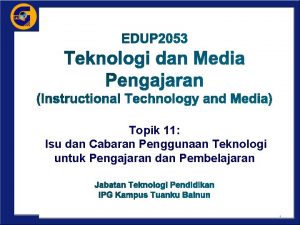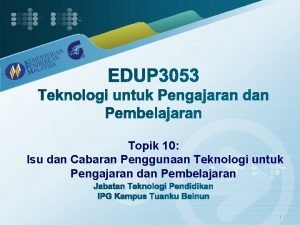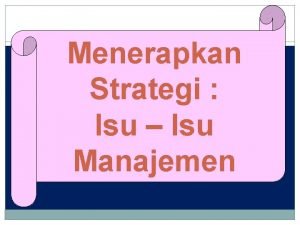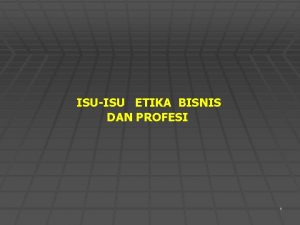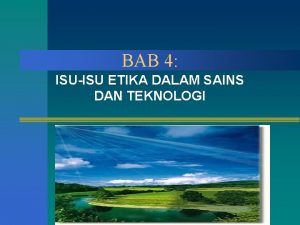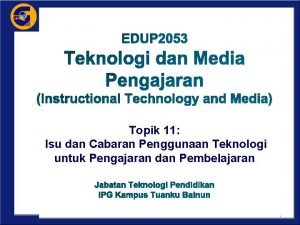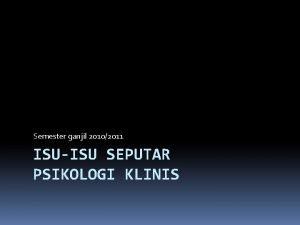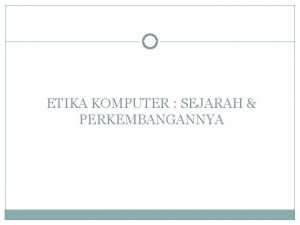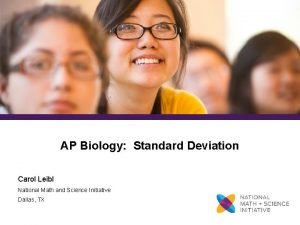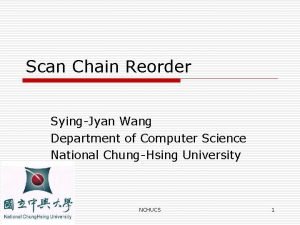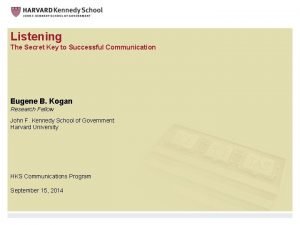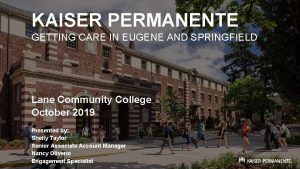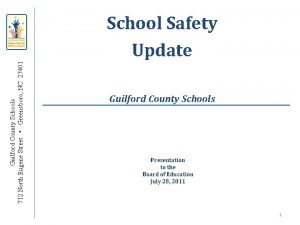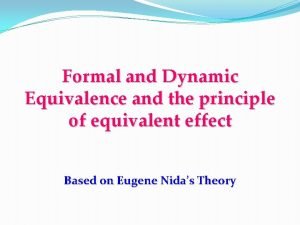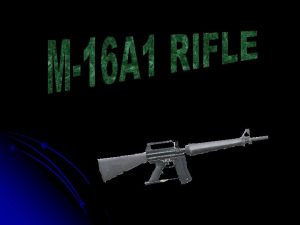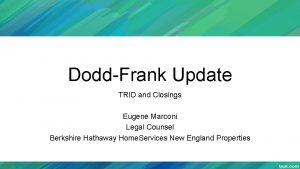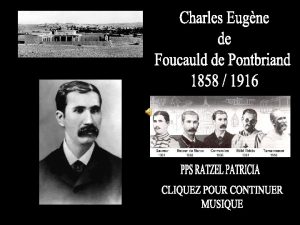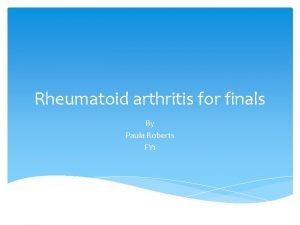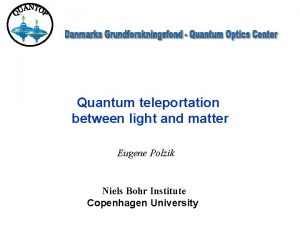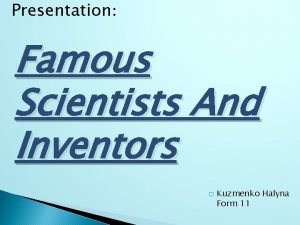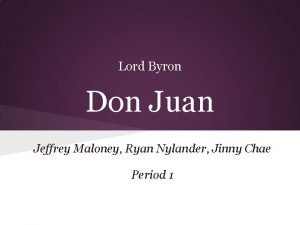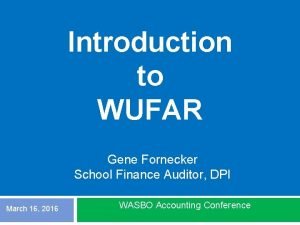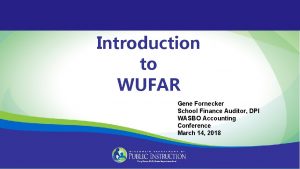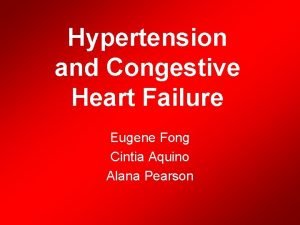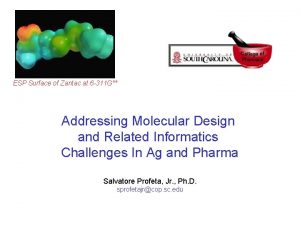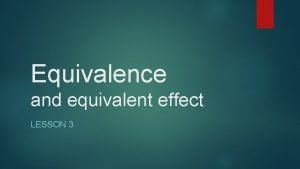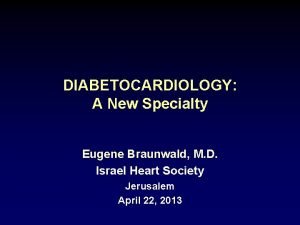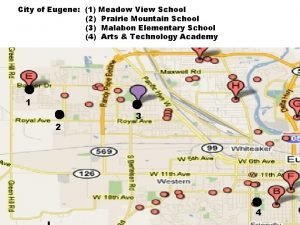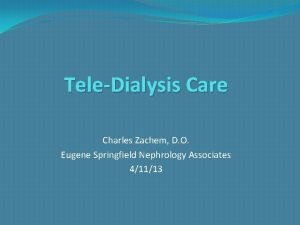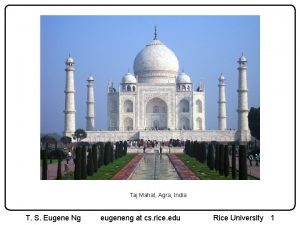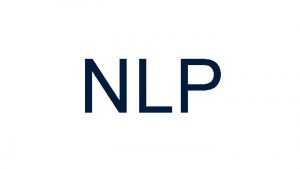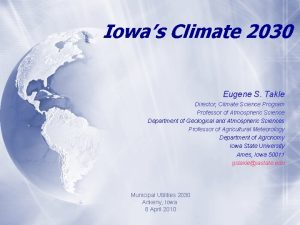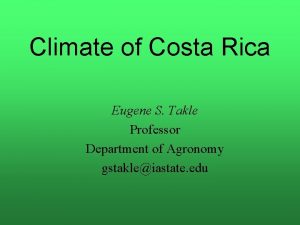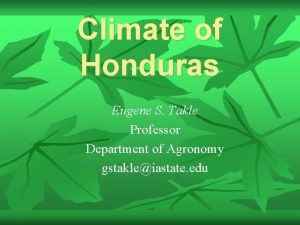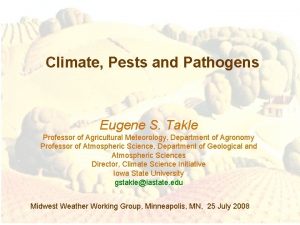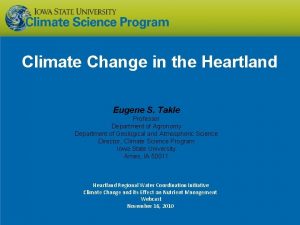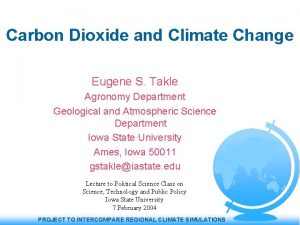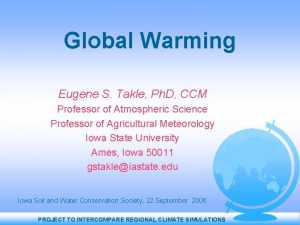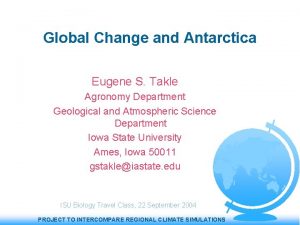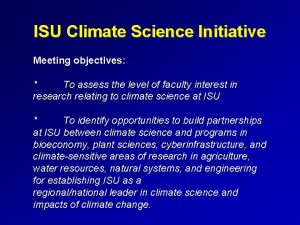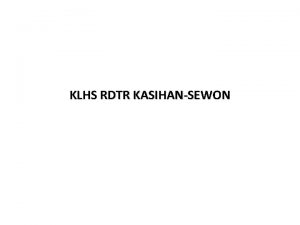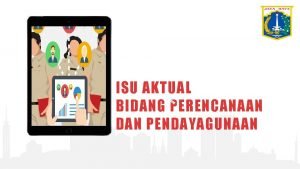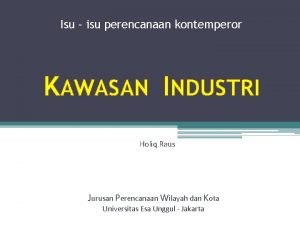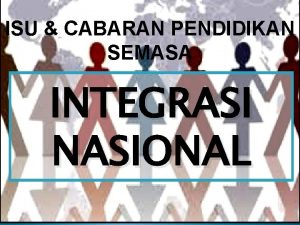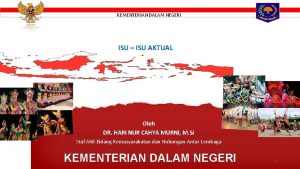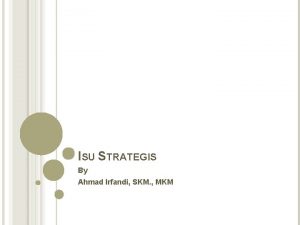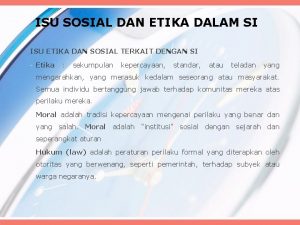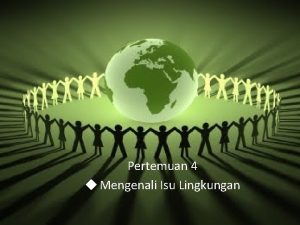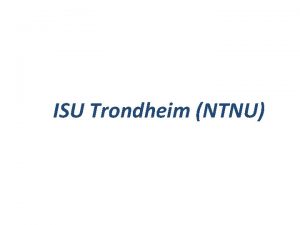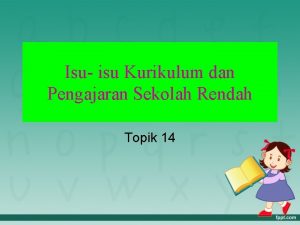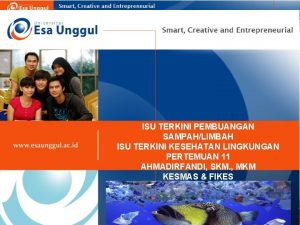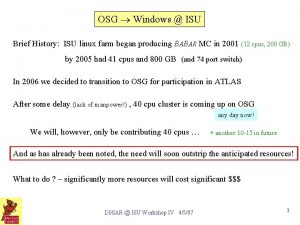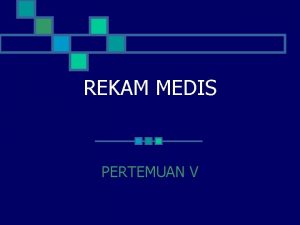ISU Climate Science Initiative Eugene S Takle Professor









































- Slides: 41

ISU Climate Science Initiative Eugene S. Takle Professor of Atmospheric Science Department of Geological and Atmospheric Sciences Professor of Agricultural Meteorology Department of Agronomy Iowa State University Ames, Iowa 50011 gstakle@iastate. edu Combined Faculty Meeting Agronomy and GEAT 24 January 2008 CLIMATE SCIENCE INITITATIVE, IOWA STATE UNIVERSITY

Outline Status of climate science – Climate change and climate variability – Understanding and prediction regional-scale climate change and variability and their impacts – Time scales for future climate scenarios What do we do now? ISU’s role – – NARCCAP Mi. CCA MRED Climate Science Initiative Brief history Current status Developing linkages, faculty engagement Future visions CLIMATE SCIENCE INITITATIVE, IOWA STATE UNIVERSITY

CO 2, CH 4 and temperature records from Antarctic ice core data CLIMATE SCIENCE INITITATIVE, IOWA STATE UNIVERSITY

Carbon Dioxide and Temperature “Business as Usual” 950 ppm ? CLIMATE SCIENCE INITITATIVE, IOWA STATE UNIVERSITY


Energy intensive Reduced Consumption Energy conserving IPCC Fourth Assessment Report INITITATIVE, Summary for. IOWA Policy Makers CLIMATE SCIENCE STATE UNIVERSITY

Energy intensive Reduced Consumption Energy conserving The planet is committed to a warming over the next 50 years regardless of political decisions IPCC Fourth Assessment Report INITITATIVE, Summary for. IOWA Policy Makers CLIMATE SCIENCE STATE UNIVERSITY

Energy intensive Reduced Consumption Energy conserving The planet is committed to a warming over the next 50 years regardless of political decisions IPCC Fourth Assessment Report INITITATIVE, Summary for. IOWA Policy Makers CLIMATE SCIENCE STATE UNIVERSITY

Energy intensive Reduced Consumption Energy conserving The planet is committed to a warming over the next 50 years regardless of political decisions IPCC Fourth Assessment Report INITITATIVE, Summary for. IOWA Policy Makers CLIMATE SCIENCE STATE UNIVERSITY

Energy intensive Reduced Consumption Energy conserving Mitigation Possible Adaptation Necessary IPCC Fourth Assessment Report INITITATIVE, Summary for. IOWA Policy Makers CLIMATE SCIENCE STATE UNIVERSITY

IPCC Fourth Assessment Report INITITATIVE, Summary for. IOWA Policy Makers CLIMATE SCIENCE STATE UNIVERSITY

IPCC Fourth Assessment Report Summary for Policy Makers

Observed summer (June-July-August) daily maximum temperature changes (K) between 1976 -2000 (Adapted from Folland et al. [2001]).

D. Herzmann, Iowa Environmental Mesonet

What To Do Now? North American Regional Climate Change Assessment Program Midwest Consortium for Climate Assessment (Mi. CCA) (proposed to NOAA) Multi-RCM Downscaling of CFS Seasonal Forecasts (MRED) (proposed to NOAA) ISU Climate Science Initiative CLIMATE SCIENCE INITITATIVE, IOWA STATE UNIVERSITY

What To Do Now? North American Regional Climate Change Assessment Program (WJG lead) Midwest Consortium for Climate Assessment (Mi. CCA) (proposed to NOAA) Multi-RCM Downscaling of CFS Seasonal Forecasts (MRED) (proposed to NOAA) ISU Climate Science Initiative CLIMATE SCIENCE INITITATIVE, IOWA STATE UNIVERSITY

North America Regional Climate Change Assessment Program Global models do not have sufficient spatial resolution to provide climate information at scales needed for decision-making on adapting to climate change Use results of global climate models of future scenario climates as boundary conditions for regional climate models Develop scenarios of contemporary and future climate at spatial scales of 50 km for use in assessing impacts of climate change

Terrain and land-sea boundaries in the Hadley Centre global climate model


Example Regional Model Domain

North America Regional Climate Change Assessment Program: Participants Lead agency: NSF, with contributions from NOAA and DOE R. Arritt, D. Flory, W. Gutowski, E. Takle, Iowa State University, USA R. Jones, E. Buonomo, W. Moufouma-Okia, Hadley Centre, UK D. Caya, S. Biner, OURANOS, Canada D. Bader, P. Duffy, Lawrence Livermore National Laboratories, USA F. Giorgi, ICTP, Italy I. Held, NOAA Geophysical Fluid Dynamics Laboratory, USA R. Leung, Y. Qian, Pacific Northwest National Laboratories, USA L. Mearns, D. Middleton, D. Nychka, S. Mc. Innes, NCAR, USA A. Nunes, John Roads, Scripps Institution of Oceanography, USA S. Sain, Univ. of Colorado at Denver, USA L. Sloan, M. Snyder, Univ. of California at Santa Cruz, USA

What To Do Now? North American Regional Climate Change Assessment Program Midwest Consortium for Climate Assessment (Mi. CCA) (proposed to NOAA) (EST lead) Multi-RCM Downscaling of CFS Seasonal Forecasts (MRED) (proposed to NOAA) ISU Climate Science Initiative CLIMATE SCIENCE INITITATIVE, IOWA STATE UNIVERSITY

How Will New Trends and Variability of Regional Climate Change Affect Crop & horticulture production Soil erosion Conservation practices Water supplies Streamflow Water quality Beef and pork daily gains Livestock breeding success Milk and egg production Crop and livestock pests and pathogens Agricultural tile drainage systems Natural ecosystem species distributions Human health Building designs Recreation opportunities River navigation Roads and bridges Who will provide authoritative information? How will it be delivered? CLIMATE SCIENCE INITITATIVE, IOWA STATE UNIVERSITY

Proposed new Midwest Consortium for Climate Assessment (Mi. CCA)

Midwest Consortium for Climate Assessment (Mi. CCA) Mi. CCA’s mission is to translate and enhance the latest NOAA climate forecast products to maximize economic gains for agricultural producers and their agribusiness service providers in the U. S. Midwest through use of advanced regional models, interactive web-based decision-making tools, and high-volume customized delivery and feedback through the existing integrated regional, state, and county level extension service network throughout the 9 -state region (MN, IA, MO, WI, IL, MI, IN, OH, KY).

Midwest Consortium for Climate Assessment (Mi. CCA) Create seasonal climate forecasts for the Midwest Use ensembles of advanced regional climate models interactive web-based decisionmaking tools, Translate and enhance the latest NOAA climate forecast products to maximize economic gains Use high-volume customized delivery and feedback through the county level extension service network CLIMATE SCIENCE INITITATIVE, IOWA STATE UNIVERSITY

What To Do Now? North American Regional Climate Change Assessment Program Midwest Consortium for Climate Assessment (Mi. CCA) (proposed to NOAA) Multi-RCM Downscaling of CFS Seasonal Forecasts (MRED) (proposed to NOAA) (RWA lead) ISU Climate Science Initiative CLIMATE SCIENCE INITITATIVE, IOWA STATE UNIVERSITY

Seasonal Forecasting (MRED project) Weather forecasting is short-term (few days to 2 weeks) Climate projection is for decades Seasonal forecasting has had less attention, despite practical needs: – agriculture, construction and repair, transportation, etc. CLIMATE SCIENCE INITITATIVE, IOWA STATE UNIVERSITY

Seasonal Forecasting (MRED project) MRED project is patterned after NARCCAP: – uses output from the National Centers for Environmental Prediction (NCEP) global model as input to fine-scale regional models – many of the same participants as NARCCAP ISU has done some exploratory work using a similar approach. Project has been proposed to NOAA. CLIMATE SCIENCE INITITATIVE, IOWA STATE UNIVERSITY

What To Do Now? North American Regional Climate Change Assessment Program Midwest Consortium for Climate Assessment (Mi. CCA) (proposed to NOAA) Multi-RCM Downscaling of CFS Seasonal Forecasts (MRED) (proposed to NOAA) ISU Climate Science Initiative (EST lead) CLIMATE SCIENCE INITITATIVE, IOWA STATE UNIVERSITY

ISU Climate Science Initiative Launched by Vice President Brighton Colleges of Agric, Engr, LAS have taken leadership, but broad campus research participation will be emphasized Build on research strengths in regional climate modeling, agriculture, water, landscapes, engineering CLIMATE SCIENCE INITITATIVE, IOWA STATE UNIVERSITY

Climate Science Initiative Vision: That Iowa State will be the leading US university in forecasting climate at regional scales with lead times of two weeks to multi-decadal for use in decision-making. A major component of the nation’s food supply and renewable fuel supply is vulnerable to both natural cycles of climate and changes due to increases in atmospheric greenhouse gases. Failure to anticipate major floods and droughts of regional scale will create profound shocks to the nation’s economy. Recent advances in forecasting global climate out to nine years by use global climate models initialized with new measurements of “ocean heat content” as reported in Science raise prospects for increased predictability on seasonal and longer time scales

Climate Science Initiative: Progress So Far Held informational meeting Nov 26 – 75 attended (additional 20 sent regrets) – 59 faculty, 16 staff/admin – 22 departments, 5 colleges Reported back to VPRED advisory team – VP Brighton, Deans Wintersteen, Whiteford, Kushner – Approval to move forward – Hired web master, invite speakers Forming Climate Science Initiative Council Forging linkages with other programs

Build Links to other Institutes and Centers Bioeconomy Institute Plant Sciences Institute Cyber. Innovation Institute Center for Carbon-Capturing Crops Center for Computational Intelligence, Learning, and Discovery Research Computing Council Ames Laboratory CARD ISU Extension Service Great Lakes Consortium for Petascale Computing CLIMATE SCIENCE INITITATIVE, IOWA STATE UNIVERSITY

Examples of Studying Impacts of Climate Change Impact of land-use and climate change on future landscape change (C. Kling, CART) Impact of climate change on stream flow in UMRB (C. Kling, P. Gassman, M. Jha, CARD) Impact of climate change on tile drainage flow (A. Kaleita, M. Helmers, A&BE) Pavement performance under climate change (C. Williams, CCEE) Changes in wind speed and wind power under climate change (S. Pryor, Indiana U) CLIMATE SCIENCE INITITATIVE, IOWA STATE UNIVERSITY

Future Role of Cyberinfrastructure in Universities “…leadership in cyberinfrastructure may well become the major determinant in measuring pre-eminence in higher education among nations. ” Arden L. Bement, Jr. Director, National Science Foundation CLIMATE SCIENCE INITITATIVE, IOWA STATE UNIVERSITY

Virtual Environmental Observatories Assemble comprehensive historical databases on environmental measurements – – – – Meteorological Streamflow Ground water Soil moisture Soil carbon Crop growth Water quality Air quality CLIMATE SCIENCE INITITATIVE, IOWA STATE UNIVERSITY

Virtual Environmental Observatories: Assemble comprehensive historical databases on environmental measurements Meteorology, streamflow, ground water, soil moisture, soil carbon, crop growth, water quality, air quality Landscape information (elevations, soil types, land -use, land cover, animal/bird populations, drainage, tillage, cropping patterns, chemical application, conservation practices, ownership, etc. ) Human demographics (population, built environment, pollutant sources, etc. ) CLIMATE SCIENCE INITITATIVE, IOWA STATE UNIVERSITY

Virtual Environmental Observatories: Assemble dynamical models for imposing physical constraints and consistency Physical laws Balances Consistency CLIMATE SCIENCE INITITATIVE, IOWA STATE UNIVERSITY

Virtual Environmental Observatories: Forecast future conditions with applications to Extreme weather events Flood/drought impacts Roadway safety Emergency management Advance preparedness Toxic releases Crop development Agriculture decision-making – purchase, tillage, planting, marketing Recreational opportunities CLIMATE SCIENCE INITITATIVE, IOWA STATE UNIVERSITY

Where Do We Go From Here? Continue to solicit faculty participation Form Council Build off-campus partnerships Seek funding opportunities Establish grants facilitation Prepare to compete for a presidential initiative Prepare to compete for a federally funded center CLIMATE SCIENCE INITITATIVE, IOWA STATE UNIVERSITY
 Metode analisis isu
Metode analisis isu Perusahaan multidomestik
Perusahaan multidomestik Isu lintas budaya
Isu lintas budaya Isu isu kewirausahaan
Isu isu kewirausahaan Isu etika dalam penulisan
Isu etika dalam penulisan Isu etika dalam penulisan akademik
Isu etika dalam penulisan akademik Simkuliah fkip
Simkuliah fkip Isu pemasaran
Isu pemasaran Isu isu etika bisnis
Isu isu etika bisnis Isu etika dalam teknologi maklumat
Isu etika dalam teknologi maklumat Isu dan cabaran penggunaan teknologi untuk pdp
Isu dan cabaran penggunaan teknologi untuk pdp Isu isu psikologi klinis
Isu isu psikologi klinis Isu isu etika komputer
Isu isu etika komputer Promotion from associate professor to professor
Promotion from associate professor to professor Climate change 2014 mitigation of climate change
Climate change 2014 mitigation of climate change What's your favorite lesson
What's your favorite lesson National math and science initiative ap biology
National math and science initiative ap biology Eugene jyan
Eugene jyan Eugene b kogan
Eugene b kogan Santa clara peacehealth
Santa clara peacehealth Guilford county schools eugene street
Guilford county schools eugene street Eugene talmadge definition
Eugene talmadge definition Dynamic equivalence definition
Dynamic equivalence definition Eugene stoner
Eugene stoner Eugene marconi
Eugene marconi Charles eugène de foucauld de pontbriand
Charles eugène de foucauld de pontbriand Dr eugene lim rheumatologist
Dr eugene lim rheumatologist Eugene polzik
Eugene polzik Halyna kuzmenko
Halyna kuzmenko Eugene mcdarby
Eugene mcdarby Don juans eugene
Don juans eugene Eugene fornecker
Eugene fornecker Eugene fornecker
Eugene fornecker Eugene fong
Eugene fong Eugene logusch
Eugene logusch Werner koller equivalence
Werner koller equivalence Eugene braunwald
Eugene braunwald Meadowview school eugene
Meadowview school eugene Eugene springfield nephrology
Eugene springfield nephrology T. s. eugene ng
T. s. eugene ng Joseph puchberger
Joseph puchberger Eugene qeather
Eugene qeather
